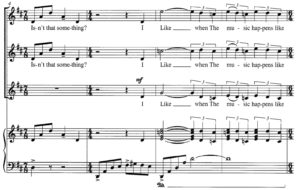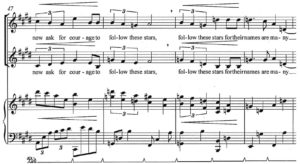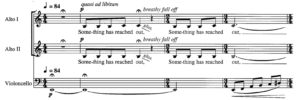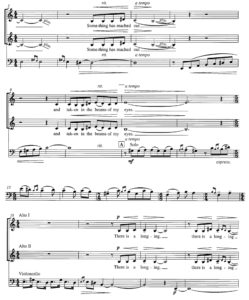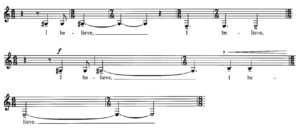Por Kelly Miller
David L. Brunner (n. 1953) es uno de los compositores corales más prolíficos de finales del s. XX y comienzos del XXI. Se lo interpreta y recibe encargos para obras corales en los Estados Unidos frecuentemente; en 2015 compuso más de 150 obras corales. De sus 150 obras, 67 están registradas por los editores y su sitio web bajo el título de coro de voces agudas, amplio descriptor vocal referido a la voz femenina y la masculina que aún no ha mudado. Independientemente de esta etiqueta, la mayoría de piezas de Brunner para voces agudas son eminentemente adecuadas para coros femeninos: un conjunto avanzado de escuela secundaria avanzada, un coro universitario, o un comunitario; 22 de sus obras apuntan a este grupo. Esto se debe, en parte, a textos maduros, melodías neo-románticas, y experimentación con tonalidades ajenas a la tradición del arte coral occidental. Este artículo echa un breve vistazo a cómo Brunner comenzó a componer y centrarse en su selección de textos, elementos melódicos, lenguaje armónico, acompañamientos, rango vocal, timbre, textura coral, e indicaciones en la partitura, especialmente para coros femeninos avanzados.
El comienzo
El viaje de Brunner como compositor ocurrió orgánicamente, con sus primeras experiencias con la voz aguda que dieron forma a su destreza compositiva. Después de su graduación universitaria en 1975, se pidió a Brunner que escribiera una pieza para voces agudas para los próximos conciertos de Navidad de Illinois Wesleyan. La melodía titulada Little Baby, Did You Know, fue escrita para el Coro Femenino de la Illinois Wesleyan University, dirigido por el Dr. Sammy Scifres.[1] Después de Wesleyan, comenzó escribiendo arreglos para sus propios coros para satisfacer sus diversas necesidades. Compuso según fuera necesario, y Doreen Rao lo ayudó a crear una audiencia nacional para sus obras. Brunner declaró: “Creo que [Rao], más que nadie, es responsable de fomentar todo esto [su carrera compositiva]. Cómo empecé a hacer esto, o incluso pensé que podía hacer esto, o debería hacer esto, o que de alguna manera hace que me sienta bien para lograr esto. Ella realmente fue fundamental desde el principio en eso.”[2]
Rao inmediatamente conectó con la música de Brunner. Cuando ella comenzó a desarrollar la serie Choral Music Experience con Boosey & Hawkes en 1986, le animó a presentar su música coral en vistas a publicación. Clásicos de la CME como Hold Fast sus sueños para voces blancas y O música para coro SATB, violonchelo y el piano comenzó a definirlo como un compositor talentoso cuyo amor por la gran poesía y sensibilidad a la voz se combinaron para caracterizar su manera de escribir en los Estados Unidos y en el extranjero.
Con la experiencia llega una libertad para tomar más riesgos. En tanto sus composiciones evolucionaban, Brunner comenzaba a elegir textos maduros que que fueran sensuales y provocativos. Se tornó más interesado en la música ajena a la tradición del arte clásico occidental y en experimentar con lo desconocido. Ha escrito para diversos instrumentos y pidió a cantantes a probar nuevos estilos vocales. Brunner se encuentra siendo atraído por música con mensaje, música que marca una diferencia en las vidas de los cantantes y del público.
Selección de textos
La selección del texto es el elemento más importante del proceso compositivo de Brunner. El enfoque de Brunner para seleccionar textos contiene elementos diversos: período de tiempo, edad, la cultura, construcción métrica, y “cómo” y “por qué” él decide cambiar un texto en su disposición musical. Sostiene que los directores nunca experimentan verdaderamente la música hasta que entienden el poema -su contenido y significado, así como la arquitectura, el ritmo y la rima. Brunner sostiene: “El impulso básico para la composición de la música vocal es el texto. La música vocal ¡es texto! Puesto que la música y las palabras están estrechamente relacionadas, los textos deben ser de integridad y valor literario. Esta integridad y valor se apoyan más en la calidad de los versos que en la sofisticación, ya sea soneto o quintilla.”[3] Su rigurosa aproximación a la selección de textos guía su uso y tratamiento de literatura diversa que abarca una variedad de períodos de tiempo, poetas, y construcciones métricas.
Para su música para coros femeninos, elige poetas tanto en el pasado (San Francisco de Asís, Mirabai, John Davies, John Newton, William Blake, y e. e. Cummings) y presente (William Austin, Janet Lewis, Seamus Heaney, y Ann Ziety). Se destacan los textos de 16 poetas femeninas, incluyendo la poeta canadiense del siglo XX Margaret Atwood, la americana Louise Driscoll, nacida en el último tercio del siglo XIX, y Mirabai del siglo XVI en la India.
Rara vez omite palabras pero, en ocasiones, ha combinado textos o escrito los suyos. Por ejemplo, la inspiración para All Thy Gifts of Love se originó como un verso de la Hunger Fund Committee de la Diócesis de Huron, que recibió como saludo de Navidad. Incorporó este fragmento con las palabras de una oración del el Rev. Russell Galen. En Simple Boat, para coros femenino y mixto, una oración de un pescador irlandés representa la difícil situación de los niños con los adultos de la comunidad, respondiendo con dos pasajes del texto budista El Camino del Bodhisattva.
Elementos melódicos
Una de las cualidades más atractivas de la música de Brunner es su escritura melódica. Crea hermosas melodías que llevan la poesía a la vida. Lynn Gackle declaró: “Es difícil hablar de su música sin analizar su don para la melodía.”[4] Emily Ellsworth acordó: “[Las melodías de Brunner son] … muy cantables -aprovechando al máximo la capacidad de los cantantes para hacer girar una línea musical.”[5] Sus melodías perduran en la memoria tanto de público como de intérpretes.
Las melodías de Brunner reflejan su habilidad para reforzar el texto, destacándolo con la altura y la duración de las sílabas. Pretende crear una línea que “cante como se habla.”[6] Él desea que el énfasis orgánico de la palabra y el ritmo del habla creen un delineado de texto, y emplea el ritmo, el contorno melódico, los cambios de tempo, los metros alternados, y el entrelazado de sílabas tónicas y átonas para enfatizar la acentuación natural de la palabra.
Lenguaje armónico
Otra de las características compositivas de las obras de Brunner es el lenguaje armónico con el que sostiene sus melodías; es diatónica y tonal. Piezas características que permanecen en una tonalidad son Winter Changes, Hold Fast Your Dreams, Home, If I Could Fly, y A Song For Every Child. Brunner no tiene miedo de utilizar disonancias. Le gusta escribir música que se desvía de un centro tonal como se ve en This Magicker and Star Giver. The Circles Of Our Lives, Isn’t That Something, Radiant Sister of the Day, y Rain Stick, favorece de una concepción de la tonalidad céntrica, sin embargo moderna, que implica notas cromáticas y sonidos que no conformas acordes, que le permiten apartarse de la tonalidad establecida. Sir Brother Sun and Southern Gals son ejemplos de piezas que contienen múltiples modulaciones.
Una característica típica tanto en el lenguaje melódico como armónico es su empleo de intervalos extendidos o, “saltos brunnerianos”. Novenas y oncenas son las opciones principales de Brunner, como se ha visto con el do 4 a re 5 en c. 40 a c. 41 (Figura 1), y el re 4 a mi 5 en c. 5 a c. 6 (Figura 2). Ambos ejemplos demuestran una consciente voz cantante y una estructura armónica que apoya los intervalos melódicos.
Figura 1: Winter Changes, cc. 39-42
Figura 2: Isn’t That Something?, cc. 4-7
Un elemento más reciente y emocionante en el lenguaje armónico de Brunner es el empleo de sonoridades no occidentales. Para All I Was Doing Was Breathing, Brunner investigó la música india, pero comenzó a componer sin un modo específico o escala en mente; una tonalidad mi-fa-sol#-la-si-do-do# surgió mientras la pieza se desarrollaba. Este patrón de intervalos se asemeja a los de los raga thaat de Bhairav, do-re -mi-fa-sol-la-si, conjunto de sonidos utilizados en la música clásica del norte de la India.[7] Los thaat indios no son fijos y pueden comenzar en cualquier nota.[8]
Acompañamientos
Casi todas las piezas de Brunner se escriben con acompañamiento de piano. La complejidad de la escritura pianística y la dificultad de ejecución son variables. Rara vez escribe piezas puramente a cappella. Varias están disponibles en ediciones para metales, de cámara, y orquesta completa. Muchas de sus obras contienen piezas para instrumentos obbligato como flauta, oboe y violonchelo. Otras piezas contienen una gran variedad de instrumentos de percusión, que van desde crótalos y palos de lluvia a tabla. Sus acompañamientos de piano reflejan un consumado pianista: pueden ser un desafío. Como se ve en las Figuras 1 y 2, armónicamente refuerzan sus melodías. Un ejemplo de sus características pianísticas es la escritura rítmica de 2 contra 3. En el c. 47 (Figura 3) de Star Giver, el coro canta tresillos de negra en tanto la mano derecha toca corcheas, y la mano izquierda toca tresillos de corcheas.
Figura 3: Star Giver, cc. 47-50
El acompañamiento poco convencional de All I Was Doing Was Breathing lo diferencia de todos los demás de la música de Brunner. Los músicos corales acostumbrados a canciones con piano o a cappella son desafiados durante los primeros ensayos con violonchelo. Es un aliado, como las voces, y comparte el material melódico al principio de la obra, haciéndose cargo de la melodía como solista en los cc. 11 a 19 (Figura 4). El cello luego se instala en un papel de apoyo en el c. 19 donde proporciona estabilidad de afinación.
Figura 4: All I Was Doing Was Breathing, cc. 1-21
Ámbito vocal
Brunner maximiza el ámbito vocal completo de las mujeres adultas. Sus melodías tienden a ser muy fluidas, a plena voz, y abarcando el ámbito completo. Una amplia gama vocal y tesitura con frecuencia hablan de la dificultad de una obra. Las partes de soprano tienden a oscilar entre do 4 y sol 5, y las de contraltos entre sol 3 y re 5. La siguiente parte de Alto II de All I Was Doing Was Breathing rara vez entre al pentagrama en clave de Sol. La profundidad de este rango (Figura 5) puede ser un desafío para los coros de jóvenes, pero intensifica el sonido cuando canta un conjunto experto.
Figura 5: All I Was Doing Was Breathing, cc. 149-158
Timbre
Con su excepcional conocimiento de la voz femenina, Brunner desafía a los coros femeninos avanzados pidiendo una amplia gama de colores vocales teniendo en cuenta la forma vocal, la edad de la voz, el tono, el rango, la dinámica, la tesitura, la textura y descripciones adicionales detalladas en la música . Sandra Snow ha encargado e interpretado su música durante más de veinte años, con coros de niños, de jóvenes y de adultos. En una entrevista de agosto de 2009, Snow habló de su capacidad de comprender la voz femenina en relación con el timbre.
Creo que es su conceptualización del instrumento agudo, de qué colores están disponibles para el instrumento agudo, lo que es tan interesante. No es puramente una cuestión de rango y tesitura; tiene mucho más que ver con los tonos del color. Creo que el instrumento para el que mejor escribe es para el violonchelo -esa rica y magnífica sonoridad del violonchelo. Brunner lo ama y utiliza a menudo. Él simplemente toma la paleta de colores y la convierte en la expectativa para la voz aguda que vemos en su música. De esa manera, se siente estupendo para cantar. No son sólo las subidas y bajadas, o los saltos, o la manera en que plantea la línea melódica. El color está determinado por lo que escribe en la partitura, que es una paleta más ancha de la que tal vez algunos están acostumbrados a escuchar.[9]
Textura coral
La textura de las obras corales de Brunner señala otro elemento del estilo propio de su música. En la mayoría de su música para voces femeninas, emplea una textura homofónica. Teje en líneas melódicas individuales, variando de voz a voz. Rara vez cruza las partes vocales. La sonoridad de la música para voces femeninas avanzadas oscila entre unísonos hasta múltiples configuraciones soprano-alto. No importa qué tan similares, la construcción y la textura de sus obras varía con cada pieza.
Indicaciones en la partitura
Brunner da específicas indicaciones en las partituras, comunicando claramente sus pensamientos acerca del tempo, las dinámicas y articulaciones. Comienza la mayoría de las obras con una indicación de metrónomo y un descriptor, en términos italianos o ingleses, o una frase como “with a feeling of two beats to a measure” (“con un sentimiento de dos tiempos a un compás”). Él cree que el tempo debe ser fluido y puede que tenga que cambiar el ritmo varias veces dentro de un pieza para expresar el texto.[10] De interés es la frecuencia y dónde elige incorporar las sutilezas de accelerando y ritardando, dando al director cierta flexibilidad. Por ejemplo, la introducción de piano de The Singing Will Never Be Done contiene un cambio de tempo en cada uno de los 7 primeros compases, y 23 indicaciones de tempo adicionales se indican en toda la partitura. Brunner explota el espectro más amplio tanto en amplitud vocal como instrumental, creando contraste dinámico. Aumenta la fuerza del texto con ligaduras, tenuto y acentos articulados.
Resumen
David Brunner tiene la capacidad de elegir textos potentes y disponerlos con una hermosa melodía. Selecciona ingeniosamente textos sugerentes que hablan a las sensibilidades emocionales y la sofisticación de las mujeres adultas. Se puede conjeturar que tiene la capacidad de aprovechar estos elementos a través de su comprensión de la voz femenina madura y extraer las posibilidades expresivas de un coro. Las cantantes avanzadas aprecian el desafío de cantar su música.
Mientras evolucionaba como compositor, Brunner abogó por el repertorio de calidad que marca la diferencia en la vida de cantantes. Él se siente atraído a la música con un mensaje y, en 2011, escribió una pieza para Hábitat para la Humanidad. “A cualquier director novato a las voces femeninas/blancas le sería de mucho beneficio la exploración de la música de David Brunner. Es vocal, intelectual y emocionalmente gratificante para las voces agudas de todas las edades”, afirma Emily Ellsworth. Cuando se le solicitó a la catalogadora Doreen Rao describir cómo ha visto evolucionar las composiciones de Brunner, ella respondió: “Continuamente. Un reflejo directo del carácter y las elecciones de vida del compositor”.[11]
Kelly A. Miller es coordinadora de Educación Musical en la University of Central Florida, donde también dirige el Coro y Ensamble femenino. La Dra. Miller enseñó música coral en la escuela secundaria durante trece años en Michigan, Florida, y Nebraska. Antes de dirigir coros, Miller enseñó Banda para los grados V a XII, Teoría de la música, y la Música general elemental. Miller tiene la National Board Certification en música coral para la escuela secundaria, y un D.M.A. en Dirección Coral de la Universidad Estatal de Michigan.
Traducido del inglés por Oscar Llobet, Argentina
Revisado por Juan Casabellas, Argentina
[1] Entrevista, el autor y David Brunner, 11 de Julio de 2009 (Orlando, Florida).
[2] Entrevista, el autor y David Brunner, 11 de Julio de 2009 (Orlando, Florida).
[3] David Brunner, “Choral Repertoire: A Director’s Checklist,” Music Educators Journal 79, No 1 (1992), 32.
[4] Entrevista, el autor y Lynn Gackle, 24 de marzo de 2010 (por correo electrónico).
[5] Entrevista, el autor y Emily Ellsworth, 9 de abril de 2010 (por correo electrónico).
[6] Entrevista, el autor y David Brunner, 11 de julio 2009 (Orlando, Florida).
[7] Walter Kaufmann, The Ragas of North India (Bloomington, IN: Indiana University Press, 1968), 233.
[8] Catherine Schmidt-Jones, “Indian Classical Music: Tuning and Ragas,”
http://cnx.org/content/m12459/1.10/ (con acceso el 4 de mayo de 2010).
[9] Entrevista, el autor y Sandra Snow, 4 de agosto de 2009 (East Lansing, Michigan).
[10] Entrevista, el autor y David Brunner, 11 de julio de 2009 (Orlando, Florida).
[11] Entrevista, el autor y Doreen Rao, 2 de febrero de 2010 (por correo electrónico).



